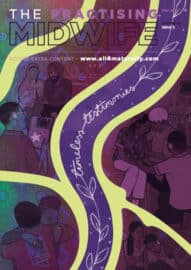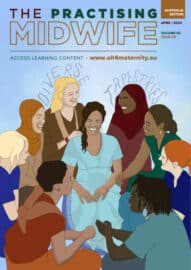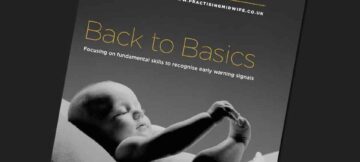Independent Midwifery is Back!
Sarah Fitzsimmons (she/her) – My Independent Midwife Ltd
Instagram @myindependentmidwife
Introduction

Independent midwifery used to be a readily available option for pregnant women, people and midwives alike. However, with changes in legislation, the art of true independent midwifery for birth had been lost. In the summer of 2022, independent midwifery returned, including birth support thanks to a new innovative indemnity insurance product.
What is an independent midwife?
An independent midwife or IM, is a fully-qualified midwife that works outside of the NHS as a self-employed professional. An IM is employed privately by individual families to provide some or all of their maternity care.
An IM takes a collaborative approach with the NHS as all clients remain entitled to access any or all of their maternity care available from the NHS. An IM may attend with their client as part of a multi-disciplinary team approach to providing holistic, patient-centred care, if this is their clients wish.
An IM is required to maintain the Nursing & Midwifery Council (NMC) code of conduct and follow evidence-based care. Crucially, they are also required to have indemnity insurance.
The history of independent midwifery and insurance
Historically, The Royal College of Midwifes (RCM) provided indemnity insurance for all midwives, including those practising independently. Following a significant increase in the cost of such indemnity cover, the RCM withdrew its cover for IMs in 1994..
From 1994 until 2014, independent midwives were not legally obliged to hold indemnity insurance. But from 2002 onwards, the NMC Code recommended holding such cover and required them to advise their clients if they did not hold indemnity cover.
The NMC’s legislation was then changed in July 2014 to reflect a change in the law which now requires all healthcare provers to hold indemnity cover an appropriate indemnity arrangement.
How have IMs been able to continue working?
The Royal College of Nursing (RCN) provides insurance cover included within their union membership fees for antenatal and postnatal care.
This has limited IMs to providing only antenatal and postnatal care unless special contracts were arranged with local NHS trusts for a ‘birth on the bank’ type arrangement.
*What’s all this about new insurance?
Until now, indemnity insurance in the UK has been only available from one company that requires midwives to work under their company name. From June 2022, a new insurance product became available that allows IMs to work solely under their own name and returns the autonomy of practice and options for pregnant families to choose their own midwife.
Why would a pregnant woman choose to book an IM?
An independent midwife provides a true continuity of carer experience. The pregnant family receives all of their antenatal care, birth support and postnatal care from the same midwife, resulting in safer care, based on a relationship of mutual trust and respect.
Pregnant women and people who have continuity of carer are proven to be:1
- less likely to have an epidural
- less likely to have an episiotomy
- less likely to have a birth assisted by forceps or ventouse
- less likely to be induced
- less likely to have premature births
- at lower risk of losing their baby
And here are the benefits when there is continuity of carer during labour:
- more chance of spontaneous vaginal birth
- a shorter duration of labour
- a reduced chance of caesarean birth
- a reduced chance of forceps or ventouse
- less use of any pain relief
- a reduced use of epidural pain relief
- a better chance of healthier babies
- a better birthing experience as a whole
Being self-employed, appointments are not restricted by time, so there is ample opportunity to achieve true informed consent and explore options around birth in depth. Due to this, and the deeper understanding of client concerns, it is common for people who have experienced a previous traumatic birth to access an IM.
Why I chose to become an IM
I became an IM immediately on qualifying back in 2008, when the only requirement was to ensure clients knew that I did not have indemnity insurance for birth. At the time, the only option was to work without insurance as an insurance product did not exist.
I spent two years supporting women to birth in their chosen place of birth and empowering them to release their past birth and heal from a new positive experience. I had a full caseload and being on call just became a lifestyle.
In 2010, family illness meant that I needed a more predictable work pattern and I joined the NHS full-time. My career developed around supporting physiological birth, first as a community midwife facilitating home births, then as a birth centre core team member.
My career progressed to birth centre manager, opening and establishing a brand new birthing environment.
I adored my colleagues and enjoyed a happy, healthy team that had a strong positive impact on the people they cared for at the birth centre and the statistics for the hospital. However, I missed the time with my clients, getting to know them and empowering them with antenatal education and hypnotherapy techniques.
When it was clear that a new insurance product was coming to the market that would allow me to practise in a similar way to my previous practice, I was one of the very first to sign up.
What being an IM means to me
My husband and I have four young children and although the initial setup has been a huge learning curve – especially as someone unfamiliar with Instagram – I love the freedom that being an IM brings.
I can work my hours around the children’s school day and I’m in control of the number of clients I take on so I don’t feel overwhelmed with being on call. While the new business is establishing and we’re trying to build our name and reputation, I work for an agency covering midwifery shifts in the NHS. Again this is really flexible and takes the financial pressure off having to have a set number of clients. We can grow slowly and strong.
I work in partnership with my midwife colleague Jennifer Johnson, bringing together our skills and experiences to support our clients together at our births.
I love that Jenny and I can establish our own philosophy of care and ethos. We can share our experience and knowledge with our families and really see how healing and impactful a positive birthing experience is.
We can be professional and still have fun sharing information and tips on platforms such as TikTok and Instagram. Social media is great for breaking down barriers and introducing yourself as a person as well as a midwife.
I also enjoy the freedom to explore and grow in areas that are important to me and support my practice at a pace that suits me.
How to become an independent midwife
It’s not as hard to make the transition over to independent midwifery as you would imagine. There is lots of support available from the IM community. Independent Midwives UK offers a one-day workshop Making the Move.
At My Independent Midwife we have written a step-by-step blog on how to become an independent midwife.
The best place to start is to find an IM near you and start making connections. IMs generally work together as a large community and support each other.
If you would like some support or a friendly chat about life as IM, please feel free to contact us at My Independent Midwife.
*To find out more about access to the new insurance product please visit www.zestmidwives.co.uk.
References
- Implementing Better Births. NHS England. https://www.england.nhs.uk/mat-transformation/implementing-better-births/ Published March 28, 2017.











